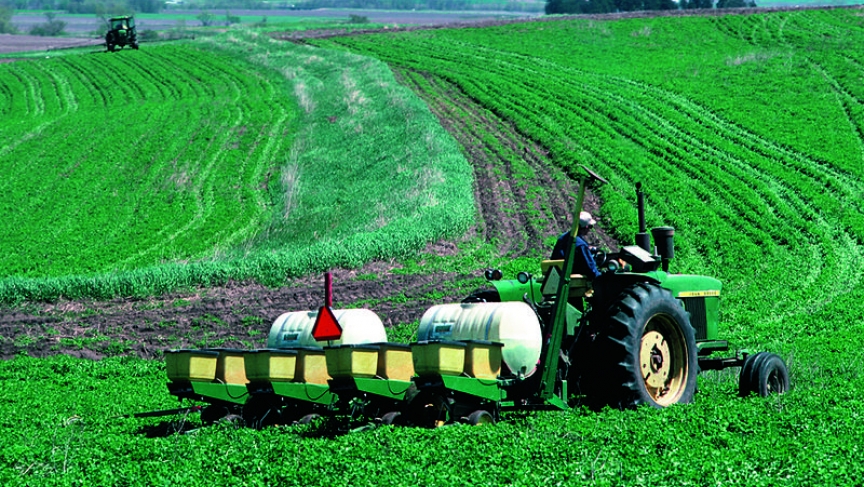
Credit: Tim McCabe/USDA Natural Resources Conservation Service. No-till planting is under way at an alfalfa field on a farm in Montgomery County, Iowa.
by Adam Wernick, PRI Science Friday, August 25, 2014
What if there were a simple solution to fighting climate change right under our feet? In her new book, The Soil Will Save Us, journalist and writer Kristin Ohlson says there is.
“The soil has been playing a mighty role in our climate ever since we've been a planet,” Ohlson says. It's full of carbon fuel that helps plants and microorganisms thrive, but today's industrial farming methods rip up the soil and release huge amounts of that carbon into the air.
Ohlson argues that returning to no-till farming practices, which leave the soil undisturbed and carbon trapped underground, will help reverse climate change and solve other pressing environmental issues at the same time. "Everything we want for our planet above the soil line depends on the activity of those microorganisms below," she says.
“Plants take carbon dioxide out of the air,” Ohlson explains. “They convert that into a carbon fuel for themselves, but they share 40 percent of that carbon fuel with the soil microorganisms. The soil microorganisms take that carbon fuel, and they eat it and they grow with it and they make a glue with it to create habitat down in the soil. All those activities fix carbon in the soil.”
But when humans came along, Ohlson says, we started “messing up nature” — with agriculture, burning forests, plowing up the soil and changing the behavior of animals on the land. Worse, we started releasing all the carbon in the soil.
One of the best solutions, Ohlson says, is also one of the simplest: no-till farming. With this method, farmers plant crops with minimal disturbance of the soil, keeping the essential system of microrganisms intact. That helps keep all of that carbon in the soil instead of releasing into the air.
David Johnson, a scientist at New Mexico State University, has been doing “amazing work,” Ohlson says, using no-till agriculture in conjuction with dense cover crops — plants, such as legumes and grasses that grow in places and at times when the ground would otherwise be bare.
Cover crops have roots in the ground that capture carbon dioxide and send carbon down into the soil, feeding the underground community of soil microorganisms. This, in turn, builds up carbon in the soil, making the soil more porous.
“So it's very healthy for the plants, it's very healthy for the land, but it's also removing a lot of carbon from the air,” Ohlson says. In fact, Johnson estimates that returning just 11 percent of the world's cropland to no-till farming could potentially offset all of our current carbon dioxide emissions.
Gabe Brown, a farmer and rancher based outside of Bismark, North Dakota, has been practicing no-till farming for 20 years. He has also greatly increased the diversity of the plants he uses on his farm.
“Nature abhors a monoculture — it likes diversity,” Brown says. “It's through that diversity that we can sequester carbon [and] put that carbon into the soil. That carbon, in turn, through the soil biology, is what produces healthy crops, healthy animals, and eventually healthy people.”
“So we're bringing the whole system together,” he says, “thinking of our farm and ranch as an ecosystem, versus the current production model, which is monocultures and low diversity.”
Farming the old-fashioned way brings other benefits, too, Brown points out. Because he no longer uses synthetic fertilizers, pesticides and fungicides, his expenses are a fraction of the conventional production model. What’s more, his yields, based on the amount of grain produced per acre, are above average in his surrounding community.
“So we're getting more production at a much lower cost,” he says. “And in turn, we're regenerating the soil, which is the important thing."
If farmers start focusing now on regenerative agriculture, they can significantly reduce the need for the fertilizers, pesticides, fungicides and herbicides within three to five years. That means dramatically less damage to the soil and to the many waterways into which they inevitably flow.
Asked if he really believes healing the soil this way in sufficient areas of land could absorb enough CO2 to make a difference, Brown is emphatic: “There's absolutely no doubt in my mind about that,” he says. “Absolutely no doubt.”
This story is based on an interview that aired on PRI's Science Friday with Ira Flatow.
http://www.pri.org/stories/2014-08-25/old-school-farming-methods-could-save-planet






No comments:
Post a Comment